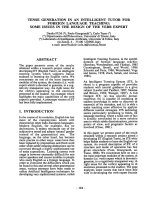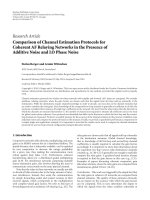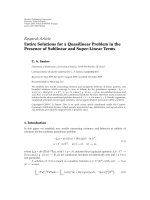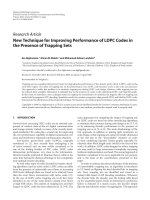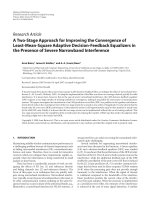Detection schemes for multi antenna FH MFSK systems in the presence of multiple follower jamming
Bạn đang xem bản rút gọn của tài liệu. Xem và tải ngay bản đầy đủ của tài liệu tại đây (534.54 KB, 149 trang )
Detection Schemes for
Multi-Antenna FH/MFSK Systems in
the Presence of Multiple Follower
Jamming
LIU FANGMING
(B.Eng, Fudan University, P.R. China)
A THESE SUBMIITED
FOR THE DEGREE OF DOCTOR OF PHILOSOPHY
DEPARTMENT OF ELECTRICAL AND COMPUTER
ENGINEERING
NATIONAL UNIVERSITY OF SINGAPRE
2010
ACKNOWLEDGEMENT
First and foremost, my deepest gratitude goes to my supervisors, Professor
Ko Chi Chung, for his enlightening guidance, supports, encouragement and
unending patience throughout the entire period of my Ph.D course and the
write-up of this thesis. His invaluable suggestions and discussions are truly
rewarding.
Special thanks to my parents, my wife, and my grandparents, who always
encourage, support and care for me throughout my life.
I am also grateful to all the colleagues and students in the
Communications Laboratory at the Department of Electrical and Computer
engineering of National University of Singapore.
ii
CONTENT
ACKNOWLEDGEMENT i
CONTENT ii
SUMMARY vii
LIST OF TABLES x
LIST OF FIGURES xi
LIST OF ABBREVIATIONS xv
LIST OF SYMBOLS xvi
CHAPTER 1
INTRODUCTION 1
1.1 Introduction of Spread Spectrum Systems 1
1.2 A Literature Review of FHSS 2
1.2.1 Slow FHSS Systems 4
1.2.2 Fast FHSS Systems 4
1.2.3 Synchronization of FH Systems 6
1.2.4 Typical Types of Jamming Against FHSS 7
1.2.5 Performance of FHSS Systems in a Jamming Environment 9
1.2.6 Anti-jamming Algorithms For FHSS Systems 11
iii
1.3 Research Objective and Contributions 12
1.4 Structure of the Dissertation 14
CHAPTER 2
SYNCHRONIZATION OF FREQUENCY HOPPING SYSTEMS 16
2.1 Introduction 16
2.1.1 Transmitted Signal Model 17
2.1.2 Received Signal Model 17
2.2 ML Estimation of Hopping Transition Time and Period 20
2.3 A Recursive Algorithm for Solving the ML Equations 25
2.4 Numerical Results and Discussions 31
2.5 Summary 366
CHAPTER 3
FH/MFSK SYSTEM WITH JAMMING IN THE PRESENCE OF FADING 38
3.1 System Model 38
3.1.1 Signal Model 39
3.1.2 Partial Band Jamming Model 39
3.2 Received Signal Model 40
3.3 Summary 43
CHAPTER 4
MAXIMUM LIKELIHOOD-BASED BEAMFORMING ALGORITHM 44
iv
4.1 Introduction of Maximum Likelihood-based Beamforming Algorithm.
44
4.1.1 ML-based Estimation of the Ratio of Jamming Fading Gains 45
4.1.2 Beamforming Algorithm of Jamming Rejection 48
4.2 Performance of MLBB Algorithm 50
4.3 Theoretical Analysis of MLBB Algorithm 55
4.3.1 General BER Expression of MLBB Algorithm 55
4.3.2 Approximate BER Expression in the Jamming Dominant
Scenario 58
4.4 Summary 61
CHAPTER 5
AREA-BASED VECTOR SIMILARITY METRIC ALGORITHM 63
5.1 Introduction of Area-based VSM Algorithm 63
5.2 Performance of Area-based VSM Algorithm 65
5.3 Theoretical Analysis of Area-based VSM Algorithm 72
5.3.1 General BER Expression of Area-based VSM Algorithm 72
5.3.2 Approximate BER Expression in the Jamming Dominant
Scenario 74
5.4 Summary 77
v
CHAPTER 6
VOLUMETRIC-BASED DETECTION ALGORITHM 78
6.1 Introduction of the Volumetric-based Algorithm 78
6.2 Performance of the Volumetric-based Algorithm 84
6.3 Theoretical Analysis of the Volumetric-based Algorithm 92
7.1.1 General BER Expression of the Volumetric-based Algorithm 93
7.1.2 Approximate BER Expression in the Jamming Dominant
Scenario 95
7.2 Summary 99
CHAPTER 7
CONCLUSIONS AND PROPOSALS FOR FUTURE RESEARCH 100
7.1 Conclusions 100
7.2 Future Works 103
BIBLIOGRAPHY 106
APPENDIX A: A BRIEF INTRODUCTION TO TFD 122
APPENDIX B: DERIVATION OF (4.8) AND (4.9) 125
APPENDIX C: DERIVATION OF (4.29) and (4.30) 127
APPENDIX D: DESCRIPTION OF TRADITIONAL ML AND SMI 129
D.1 Traditional ML 129
D.2 SMI 129
vi
AUTHOR’S PUBLICATIONS 131
vii
SUMMARY
This dissertation focuses on the performance of the frequency hopping
spread spectrum (FHSS) M-ary frequency shift keying (MFSK) systems in the
presence of follower partial band jamming noise (PBJN) over flat fading
channels. The thermal and other wideband Gaussian noises are modeled as
additive white Gaussian noise (AWGN) at the receiver.
Follower partial band jamming is recognized as an efficient strategy to
degrade the performance of FH/MFSK modulation. In this dissertation, three
anti-jamming algorithms, based on maximum likelihood-based beamforming
(MLBB), an area-based vector similarity metric (VSM), and a
volumetric-based algorithm, are proposed to reject follower jamming and carry
out symbol detection in slow FH/MFSK systems over quasi-static flat fading
channels. In addition, theoretical analysis is derived under a jamming dominant
scenario.
The MLBB algorithm which consists of a two-element array first uses an
ML-based approach to obtain an ML estimate of the ratio of the jamming
fading gains. Based on this ML estimate, a simple beamforming structure is
employed to place a null toward the follower jamming source, and symbol
detection is then performed by the ML technique. Theoretical and simulated
viii
results show the effectiveness of the proposed algorithm in combating follower
jamming.
Using the principle of vector similarity, an area-based VSM algorithm is
formulated to give an estimate of the unknown spatial correlation of the
received jamming components at the two receiver antennas. The jamming
signal can then be removed in the symbol detection process. The improved
performance of the VSM algorithm is verified by analysis under a jamming
dominant environment as well as using simulated bit error rate (BER) results.
The volumetric-based algorithm uses a multi-element array, and is
proposed to reject multiple follower jamming signals and to carry out symbol
detection in slow FH/MFSK systems over quasi-static flat fading channels.
Specifically, with the use of the proposed algorithm, which can provide an
estimate of the unknown spatial correlation of the received multiple jamming
components at the receiver antennas, jamming can be removed in the symbol
detection process. The jamming rejection capability of this algorithm is verified
by analysis under a jamming dominant environment as well as by the much
improved BER obtained in simulation studies.
In summary, the MLBB and VSM methods can reject a single jammer by
using a two-element antenna. The volumetric algorithm can reject multiple
jammers by using a multi-elements antenna. Finally, these three proposed
ix
algorithms can attain highly reliable bit detection with low BER values over a
wide range of signal and jamming power ratios.
x
LIST OF TABLES
Table 2.1
ML estimation of
ˆ
K
and
ˆ
V
24
Table 2.2 Computational complexity of the proposed ML-based algorithm
30
Table 4.1 Details of the MLBB algorithm 49
Table 4.2 Computational complexity of the proposed MLBB algorithm per
symbol 50
Table 5.1 Details of the proposed VSM algorithm 65
Table 5.2 Computational complexity of the proposed VSM algorithm per
symbol 65
Table 6.1 Details of the proposed volumetric-based algorithm 81
Table 6.2 Computational complexity of the volumetric-based algorithm per
symbol 82
Table 7.1 Computational complexity of various algorithms 101
Table 7.2 Computational complexity of Volumetric-based algorithm 102
xi
LIST OF FIGURES
Fig. 1.1 FHSS system modem 3
Fig. 2.1 Transmitted and received signal blocks 18
Fig. 2.2
Variation of
1
ˆ
(,)
f
KV from (2.60) 32
Fig. 2.3
Variation of
2
ˆ
(,)
f
KV from (2.61) 32
Fig. 2.4
Variation of
3
ˆ
(,)
f
KV from (2.62) 33
Fig. 2.5
Variation of
1
(,)KV
from (2.33) 33
Fig. 2.6
Variation of
2
(,)KV
from (2.38) 34
Fig. 2.7
Variation of
3
(,)KV
from (2.43) 34
Fig. 2.8
(,)KV
versus
K
and
V
35
Fig. 2.9
Probability of error in estimating
K
36
Fig. 4.1 Performance of the traditional ML algorithm, SMI algorithm,
algorithm proposed in [58], and proposed MLBB algorithm versus
SJR with SNR=30dB 51
Fig. 4.2 Performance of the proposed MLBB algorithm with perfect and
imperfect channel knowledge for various SJR and SNR values with
BFSK and 4 samples per symbol 52
Fig. 4.3 Performance of the traditional ML algorithm, the SMI algorithm
and the MLBB algorithm versus SNR with SJR=-30dB 53
xii
Fig. 4.4 Performance of the MLBB algorithm for various numbers of
samples per symbol 54
Fig. 4.5 Performance of the MLBB algorithm for various MFSK
modulations 55
Fig. 4.6 Theoretical (4.43) and simulated BER values of the MLBB
algorithm for various SJR and SNR values 61
Fig. 5.1 Performance of various algorithms versus SJR with 30dB SNR,
BFSK and 4 samples per symbol 67
Fig. 5.2 Performance of various algorithms versus SJR with 30dB SNR,
8-FSK and 4 samples per symbol 68
Fig. 5.3 Performance of various algorithms versus SJR with 30dB SNR,
16-FSK and 8 samples per symbol 68
Fig. 5.4 Performance of various algorithms versus SNR with 0dB SJR,
BFSK and 4 samples per symbol 69
Fig. 5.5 Performance of the VSM algorithm for various numbers of samples
per symbol with 30dB SNR and BFSK 70
Fig. 5.6 Performance of the VSM algorithm for various numbers of samples
per symbol with 30dB SNR and 16FSK 70
xiii
Fig. 5.7 Performance of the VSM algorithm with perfect and imperfect
channel knowledge for various SJR and SNR values with BFSK
and 4 samples per symbol 71
Fig. 5.8 Theoretical (5.28) and simulated BER of the VSM algorithm in
jamming dominant channels for various SJR and SNR values with
BFSK and 4 samples per symbol 76
Fig. 6.1 Performance of various algorithms versus SJR
1
with 30dB SNR,
-30dB SJR
2
, BFSK and 4 samples per symbol 85
Fig. 6.2 Performance of various algorithms versus SJR
1
with 30dB SNR,
0dB SJR
2
, BFSK and 4 samples per symbol 85
Fig. 6.3 Performance of various algorithms versus SJR
1
with 30dB SNR,
-30dB SJR
2
, -30dB SJR
3
, BFSK and 4 samples per symbol 86
Fig. 6.4 Performance of various algorithms versus SJR
1
with 30dB SNR,
-30dB SJR
2
, 8-FSK and 8 samples per symbol 87
Fig. 6.5 Performance of various algorithms versus SJR
1
with 30dB SNR,
0dB SJR
2
, 8-FSK and 8 samples per symbol 88
Fig. 6.6 Performance of the proposed volumetric-based algorithm for
various numbers of samples per symbol with 30dB SNR, -30dB
SJR
2
and BFSK 88
xiv
Fig. 6.7 Performance of various algorithms versus SNR with -30dB SJR
1
,
-30dB SJR
2
, BFSK and 4 samples per symbol 89
Fig. 6.8 Performance of the proposed algorithm with perfect and imperfect
channel knowledge for various SJR
1
and SNR values with BFSK,
-30dB SJR
2
and 4 samples per symbol 90
Fig. 6.9 Performance of various algorithms versus SJR with 30dB SNR,
BFSK and 4 samples per symbol 91
Fig. 6.10 Performance of various algorithms versus SJR with 30dB SNR,
BFSK and 4 samples per symbol 92
Fig. 6.11 Theoretical (6.45) and simulated BER of the proposed
volumetric-based algorithm in jamming dominant channels with
BFSK, -30dB SJR
2
and 4 samples per symbol 98
Fig. 7.1 Pilot-aided symbol in one hop 104
xv
LIST OF ABBREVIATIONS
AWGN additive white Gaussian noise
BER bit error rate
DSSS direct sequence spread spectrum
FH frequency hopping
FHSS frequency hopping spread spectrum
i.i.d independent identically distributed
MAI multi-access interference
MFSK
M-ary frequency shift keying
ML maximum likelihood
MLBB maximum likelihood-based beamforming
MTJ multi-tone jammer
OFDM orthogonal frequency-division multiplexing
PBJN partial band jamming noise
SJR signal-to-jamming power ratio
SJR
i
signal to the ith jamming power ratio
SMI sample matrix inversion
SNR signal to noise power ratio
TFD time-frequency distribution
VSM vector similarity metric
xvi
LIST OF SYMBOLS
i
phase shift and attenuation of the ith hop for desired signal
kp
phase shift and attenuation of the ith hop for jamming signal
p
d
pilot symbol
0b
EN ratio of bit energy of the signal to white noise energy
d
f frequency spacing between two adjacent MFSK tones
i
f
hopping frequencies of the ith hop
2
variance of the white noise
L
number of samples the receiver received
N sampling symbol rate
)(tn
j
baseband equivalent band-limited signal
e
P theoretical BER rate
R information rate
T duration of one information bit
c
T chip duration
d
T data modulator output symbol duration
s
T
sampling period
y
T
symbol duration
()d
cost function
V
number of samples per hop
xvii
p
v
jamming components of the received signal
W bandwidth
()wn
additive white Gaussian noise
X number of jamming signals
Z number of chips that the MFSK modulator is subdivided into
1
CHAPTER 1
INTRODUCTION
1.1 Introduction of Spread Spectrum Systems
Spread spectrum signals used for the transmission of digital information
are distinguished by the characteristic that their bandwidth W is much greater
than the information rate R in bits/s. Spread spectrum signals can be used for
combating or suppressing the detrimental effects of interference such as
jamming signal, signal transmitted by other users of the channel, and
self-interference due to multipath propagation.
There are two fundamental types of spread spectrum systems: direct
sequence spread spectrum (DSSS) system and FHSS system. A wideband
spread spectrum signal is generated from a data modulated carrier by
modulating the data a second time using a very wideband spreading signal. The
spreading modulation may be a phase modulation or from a rapidly changing
carrier frequency or a combination of these and other techniques. When
spectrum spreading is accomplished by phase modulation, the resultant signal
2
is called a DSSS signal. When the spectrum spreading is accomplished by rapid
changing of the carrier frequency, the resultant signal is called an FHSS signal.
1.2 A Literature Review of FHSS
In FHSS, each carrier frequency is typically chosen from a set of 2
C
(C
is a positive integer) frequencies that are spaced approximately over the width
of the data modulation spectrum available, although neither condition is
absolutely necessary. The spreading code, in this case, does not modulate the
data-modulated carrier directly but is used to control the sequence of carrier
frequencies. In the receiver, the frequency hopping is removed by mixing with
a local oscillator signal that is hopping synchronously with the received signal.
Block diagrams of the transmitter and receiver are shown in Fig. 1.1 [1].
Although PSK modulation gives better performance than FSK in an
AWGN channel, it is difficult to maintain phase coherence in the synthesis of
the frequencies used in the hopping pattern. Consequently, FSK modulation
with noncoherent detection is usually employed with FHSS signals [2].
Due to the advantages of combating narrowband interference and
multi-access interference (MAI), FHSS has been used in military applications,
3
wireless personal communications [3], and satellite communications [4-6].
Data
Modulator
data
d(t)
0
2cos( )Pt
()
d
s
t
Frequency
Synthesizer
Code
Generator
4
FH Code
Clock
1
2
3
5
k
···
Highpass
Filter
()
t
s
t
()
T
ht
(a) Transmitter
()rt
()
R
ht
4
1
2
3
5
k
()yt
(b) Receiver
Fig. 1.1: FHSS system modem
4
1.2.1 Slow FHSS Systems
Consider an MFSK data modulation for FHSS systems. The data
modulator outputs one of 2
C
tones, each lasting CT seconds, where
T
is
the duration of one information bit. Usually, these tones are spaced far enough
apart so that the transmitted signals are orthogonal. This implies that the data
modulator frequency spacing is at least
CT1 and that the data modulator
output spectral width is approximately 2 /
C
CT . Assume that, in each
c
T
seconds, or one hop duration, the data modulator output is transmitted to a new
frequency by the frequency-hop modulator.
When CTT
c
, the FHSS system is called a slow frequency hopping
system.
1.2.2 Fast FHSS Systems
In contrast to the slow FHSS systems when the hop frequency band
changes more slowly than symbols coming out of the data modulator, the
hopping frequency band can change many times per symbol in fast FHSS
systems. A significant benefit of fast FHSS is that frequency diversity gain is
5
achieved in each transmitted symbol, which is particularly beneficial in a
partial band jamming environment.
Assume that the output of the MFSK modulator is subdivided into
Z
chips. After each hop, the MFSK modulator output is hopped to a different
frequency. Because the chip duration
c
T is shorter than the data modulator
output symbol duration
d
T , the minimum tone spacing for orthogonal signals is
now
1
c
TZCT= .
The data demodulator can operate in several different modes in fast FHSS
systems. One mode is to make a decision on each frequency hopping chip as it
is received and to make an estimate of the data modulator output based on all
Z
chip decisions. The decision rule could be a simple majority vote. Another
mode would be to calculate the likelihood of each data modulator output
symbol as a function of the total signal received over
Z
chips and to choose
the largest value. A receiver that calculates the likelihood of each symbol is
optimum in the sense that minimum error probability is achieved for a given
0b
EN. Each of these possible operating modes performs differently and has
different complexity. The spread spectrum system designer must choose the
mode of operation that best solves the particular problem under consideration.
6
1.2.3 Synchronization of FH Systems
FH communications require the spreading waveforms of the transmitter
and receiver to be synchronized. If the two waveforms are not synchronized
within as little as one chip, insufficient signal energy will reach the receiver
data demodulator for reliable data detection. The task of achieving and
maintaining code synchronization is usually delegated to the receiver [7-23].
The authors of [11; 12] describe an FH transceiver using a synchronization
method based on a simple time division duplexing (TDD) frame structure. The
latter consists of a pilot tone, a frame ID, and actual data, with synchronization
being accomplished by means of energy detection and pattern matching. [16]
proposes to use Bayesian techniques to address jointly the problem of
frequency estimation and synchronization of frequency hopping signals in a FH
system. To maintain synchronization in the presence of fading or narrowband
interference, [18] propose a time division duplex packet algorithm based on
slow FH system. By using the power sum definition, [22] proposes the cost
function that has minimum at zero hop-timing error. However, the acquisition
range is quite limited.
In general, synchronization are carried out by using a pilot signal or sync
7
bit which has the disadvantages of requiring additional time slots and
bandwidth, reduces the data rate.
Alternatively, the use of a parameter estimation algorithm may be
explored in the absence of pilot signals. Specifically, [7] proposes an algorithm
that uses a time-frequency representation of the observed signal before
estimating the parameters that characterize the time-frequency trajectory of the
signal. Based on the trajectory estimated, the hopping transitions and
frequencies can be found, even though as discussed in [7], the method suffers
from an inevitable threshold effect. Similarly, [8] proposes a wavelet estimation
technique that uses an instantaneous correlation function for the detection of
frequency hopping signals. The ML-based algorithm proposed by [10] for
frequency hop synchronization does not use any pilot signal. An iterative
method is derived to estimate the hopping frequency and hop transition time at
the same time.
1.2.4 Typical Types of Jamming Against FHSS
In FHSS systems, there are four main kinds of intentionally jamming
sources. These are barrage noise, single tone, multi-tone and partial-band
jammers. Among these types of jammers, the most popular one is the barrage


